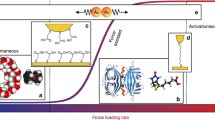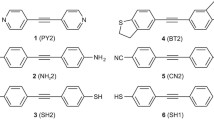Abstract
Ab initio molecular dynamics simulations have been performed of a gold—1,4-benzenedithiol (BDT)—gold nanojunction under mechanical stress. For three different pulling rates between 10 and 40 m s-1, it is found that the nanowire always ruptures between the second and third Au atom from the thiol sulfur. Larger rupture forces and longer extensions are required at higher pulling rates and vice versa. The electrical conductance was calculated along a pulling trajectory using the DFT-NEGF method to study the effect of thermal and stress-induced structural changes on the electrical transport properties. While the mechanically induced stretching of the junction is seen to lower the time-averaged conductance, thermal conformational changes are capable of altering the conductance by one order of magnitude. No single geometric quantity could be identified as the main contributor to the conductance fluctuations. Small modulations, however, can be explained in terms of C=C double bond vibrations in the BDT molecule. The dependence of the conductance on different geometric variables has further been investigated systematically by performing constrained geometry optimizations along a number of angle and dihedral coordinates. The largest changes in the conductance are observed when the Au-S-C angle and the Au-S-C-C dihedral are simultaneously constrained.

Conductance changes upon mechanical stretching of Au/BDT system









Similar content being viewed by others
References
Hakkinen H (2012) Nature Chem 4(6):443. doi:10.1038/nchem.1352
Reed MA, Zhou C, Muller CJ, Burgin TP, Tour JM (1997) Science 278(5336):252. doi:10.1126/science.278.5336.252
Park J, Pasupathy AN, Goldsmith JI, Chang C, Yaish Y, Petta JR, Rinkoski M, Sethna JP, Abruna HD, Mceuen PL, Ralph DC (2002) Nature 417(6890):722. doi:10.1038/nature00791
Reichert J, Ochs R, Beckmann D, Weber HB, Mayor M, Löhneysen (2002) Phys Rev Lett 88(17):176804. doi:10.1103/PhysRevLett.88.176804
Liang W, Shores MP, Bockrath M, Long JR, Park H (2002) Nature 417(6890):725. doi:10.1038/nature00790
Cui XD, Primak A, Zarate X, Tomfohr J, Sankey OF, Moore AL, Moore TA, Gust D, Harris G, Lindsay SM (2001) Science 294(5542):571. doi:10.1126/science.1064354
Kushmerick JG, Holt DB, Yang JC, Naciri J, Moore MH, Shashidhar R (2002) Phys Rev Lett 89(8):086802+. doi:10.1103/PhysRevLett.89.086802
Xu B, Tao NJ (2003) Science 301(5637):1221. doi:10.1126/science.1087481
Smit RHM, Noat Y, Untiedt C, Lang ND, van Hemert MC, van Ruitenbeek JM (2002) Nature 419(6910):906. doi:10.1038/nature01103
Dorogi M, Gomez J, Osifchin R, Andres RP, Reifenberger R (1995) Phys Rev B 52:9071. doi:10.1103/PhysRevB.52.9071
Andres RP, Bein T, Dorogi M, Feng S, Henderson JI, Kubiak CP, Mahoney W, Osifchin RG, Reifenberger R (1996) Science 272(5266):1323. doi:10.1126/science.272.5266.1323
Xiao X, Tao NJ (2004) Nano Lett 4(2):267. doi:10.1021/nl035000m
Tomfohr JK, Sankey OF (2002) Phys Stat Sol b 233(1):59. doi:10.1002/1521-3951(200209)
Tomfohr J, Sankey OF (2004) J Chem Phys 120(3):1542. doi:10.1063/1.1625911
Krüger D, Fuchs H, Rousseau R, Marx D, Parrinello M (2002) Phys Rev Lett 89(18):186402
Krüger D, Rousseau R, Fuchs H, Marx D (2003) Angew Chem Int Ed 42:2251
Reddy P, Jang SY, Segalman RA, Majumdar A (2007) Science 315(5818):1568. doi:10.1126/science.1137149
Borges Pontes R, Rocha AR, Sanvito S, Fazzio A, da Silva AJR (2011) ACS Nano 2:795
Strange M, Rostgaard C, Häkkinen H, Thygesen KS (2011) Phys Rev B 83:115108
Strange M, Thygesen KS (2011) Beilstein J Nanotechnol 2:746
Soler JM, Artacho E, Gale JD, García A, Junquera J, Ordejón P, Daniel NO (2002) J Phys Cond Matt 14(11):2745. doi:10.1088/0953-8984/14/11/302
Perdew JP, Burke K, Ernzerhof M (1996) Phys Rev Lett 77(18):3865. doi:10.1103/PhysRevLett.77.3865
Perdew JP, Burke K, Ernzerhof M (1997) Phys Rev Lett 78(7):1396. doi:10.1103/PhysRevLett.78
Nosé S (1984) J Chem Phys 81(1):511. doi:10.1063/1.447334
Huang F, Chen PA, Bennett T (2007) J Am Chem Soc 129(43):13225. doi:10.1021/ja074456t
Brandbyge M, Mozos JL, Ordejón P, Taylor J, Stokbro K (2002) Phys Rev B 65:165401. doi:10.1103/PhysRevB.65.165401
Xue Y, Datta S, Ratner MA (2002) Chem Phys 151(2–3). doi:10.1016/S0301-0104(02)00446-9
Fisher DS, Lee PA (1981) Phys Rev B 23:6851. doi:10.1103/PhysRevB.23.6851
Büttiker M, Imry Y, Landauer R, Pinhas S (1985) Phys Rev B 31:6207. doi:10.1103/PhysRevB.31.6207
Grandbois M, Beyer M, Rief M, Clausen-Schaumann H, Gaub HE (1999) Science 283:1727
Xu BQ, Xiao YX, Tao JN (2003) J Am Chem Soc 125:16164
Pu Q, Leng Y, Zhao X, Cummings PT (2010) J Phys Chem C 114(23):10365. doi:10.1021/jp101689u
Frei M, Aradhya SV, Koentopp M, Hybertsen MS, Venkataraman L (2011) Nano Lett 11(4):1518. doi:10.1021/nl1042903
Andrews DQ, Van Duyne RP, Ratner MA (2008) Nano Lett 8:1120
Chen W, Widawsky JR, Vásquez H, Schneebeli ST, Hybertsen MS, Breslow R, Venkataraman L (2011) J Am Chem Soc 133:17160
Diez-Perez I, Hihath J, Hines T, Wang ZS, Zhou G, Müllen K, Tao N (2011) Nature Nanotech 6(4):226. doi:10.1038/nnano.2011.20
Author information
Authors and Affiliations
Corresponding author
Rights and permissions
About this article
Cite this article
Szyja, B.M., Nguyen, H.C., Kosov, D. et al. Conformation-dependent conductance through a molecular break junction. J Mol Model 19, 4173–4180 (2013). https://doi.org/10.1007/s00894-013-1794-z
Received:
Accepted:
Published:
Issue Date:
DOI: https://doi.org/10.1007/s00894-013-1794-z




